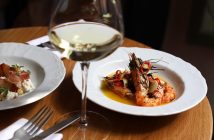The love affair the British have with sushi peddles on. It occupies both extremes: those individual pickings from train station boltholes such as Yo! Sushi and Wasabi to Michelin-starred restaurants such as Nobu and Umu.
They are worlds in which the electronic conveyer belts are forever moving, and sashimi, seaweed and hand rolls have become part of popular British vernacular, fitting into the fabric of our multinational cuisine. And the prices are going up with the demand.
For such diminutive portions – the idea being, much like tapas, that you accumulate plates, dipping in and out and sharing as necessary – these dishes do hold extraordinary costs. It’s sourcing as much as the business of demand that produces such prices.
Feng Sushi is a Japanese chain set up by a Dane, and there are outposts throughout London. Silla Bjerrum pushes and promotes the sustainability of fish, marketing Feng Sushi as ethical and environmentally concerned, as is marked on their menus by a ‘Certified Sustainable Seafood MSC’ stamp. They source from ‘innovative’ fish farms in Scotland and do not use the endangered blue fin tuna.
The menu is characteristically long, with recognisable staples such as California hand rolls and tempura. The maki listings are perhaps the most extensive: avocado, salmon and avocado, salmon skin, salmon and chives, yellow tail, yellow tail and chives, tuna, spicy tuna, tuna and avocado, prawn California, superior California, crispy salmon, tuna and tamago et al. It seems there is nothing around which you can’t wrap rice and seaweed.
The Kensington outpost, off Kensington Church Street, is smaller than a doll’s house. I am told there was once a colourful fish tank but that it was given to the Fulham branch. Poor fish; I bet they thought it was their release to freedom, only to be uprooted and plonked into another restaurant where they have no choice but to watch greedy diners eat their brothers and sisters… then forget, and have to re-witness.
There are only two tables and a high breakfast bar, which you can’t sit at because it blocks the gangway. There is no decoration or warmth.
Anouska takes the corner seat because she is petite and fits in nicely, and I bash elbows and rub backs with the gentleman behind me. When our food arrives it’s a mission to reorganise the table so that the small portions on large plates can fit. The salmon skin maki rolls have a seaweed crunch, however the rice is tough, and this is a scenario in which the right side of al dente doesn’t cut it. As they rightly suggest on the website, “Good rice is key to great sushi”.
The seared yellow fin tuna was good, dotted with soy sauce, but a fresh ginger and mirin dipping sauce that was advertised with the dish never arrived, nor did our order of organic tiger prawn tempura, but, at £11.25 for three, perhaps this was for the best.
Loch Duart salmon from the Highlands of Scotland was generously cut into thick domino slices, easy to pick up with our sustainable bamboo chopsticks, while the signature dish, scallop maki, was poor, not in the slightest a reflection of the prettily presented picture on the menu, finished with small purple borage flowers. Plump scallops had been sliced too thinly like rubbery stamps and placed on more rice and seaweed. It required some kick to lift the four rice cubes and inject life into the flat scallop slices.
I read a tweet by Feng Sushi that the scallops are hand-dived near the Isle of Mull. What a shame that after such lengths to uncover them they end up like this: flat, slimy, and lacking life.
One of the side wasabi servings was hand rolled like a Blu-Tac ball rather than a paste and we still hadn’t seen, heard or received a kidnap note from our organic tiger prawn tempura. I fear we’ll never learn the real truth.
For details of Feng Sushi restaurants across London, visit the website.





1 Comment
I do worry that they call their restaurants Feng Sushi to sound like ‘Feng Shui’ without realising that one is a Chinese term and the other is Japanese.
To some it may even be offensive.